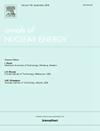假设大损失冷却剂事故下CSNS固体靶安全性能CFD分析
IF 1.9
3区 工程技术
Q1 NUCLEAR SCIENCE & TECHNOLOGY
引用次数: 0
摘要
本研究考察了中国散裂中子源(CSNS)二期目标站在假设的冷却剂大损失事故(LOCA)中的热行为,其中冷却剂通道被0.11 MPa的氮气取代。散热依靠自然对流和辐射。STAR-CCM +中的CFD模拟分析了目标材料导热系数、辐射传热系数和表面传热系数对温度分布的影响。在500千瓦的基础质子束功率上有20%的余量,目标材料的热导率降低了20%。在没有辐射模型的情况下,峰值温度达到490℃,而在S2S辐射模型下,峰值温度降至420℃,突出了辐射的关键作用。将表面换热系数从10增加到20 W/(m2·K),效果不明显。本文章由计算机程序翻译,如有差异,请以英文原文为准。
CFD analysis on the safety performance of CSNS solid target under a postulated large loss of coolant accident
This study examines the thermal behavior of the China Spallation Neutron Source (CSNS) Phase II target station during a hypothetical large loss of coolant accident (LOCA), where coolant channels are replaced by nitrogen gas at 0.11 MPa. Heat dissipation relies on natural convection and radiation. CFD simulations in STAR-CCM + analyze the impact of target material thermal conductivity, radiative heat transfer, and surface heat transfer coefficients on temperature distribution. A 20 % margin above the 500 kW baseline proton beam power and a 20 % reduction in target material thermal conductivity are applied. Without radiation modeling, the peak temperature reaches 490 ℃, but with the S2S radiation model, it drops to 420 ℃, highlighting radiation’s critical role. Increasing the surface heat transfer coefficient from 10 to 20 W/(m2·K) has a modest but notable effect.
求助全文
通过发布文献求助,成功后即可免费获取论文全文。
去求助
来源期刊

Annals of Nuclear Energy
工程技术-核科学技术
CiteScore
4.30
自引率
21.10%
发文量
632
审稿时长
7.3 months
期刊介绍:
Annals of Nuclear Energy provides an international medium for the communication of original research, ideas and developments in all areas of the field of nuclear energy science and technology. Its scope embraces nuclear fuel reserves, fuel cycles and cost, materials, processing, system and component technology (fission only), design and optimization, direct conversion of nuclear energy sources, environmental control, reactor physics, heat transfer and fluid dynamics, structural analysis, fuel management, future developments, nuclear fuel and safety, nuclear aerosol, neutron physics, computer technology (both software and hardware), risk assessment, radioactive waste disposal and reactor thermal hydraulics. Papers submitted to Annals need to demonstrate a clear link to nuclear power generation/nuclear engineering. Papers which deal with pure nuclear physics, pure health physics, imaging, or attenuation and shielding properties of concretes and various geological materials are not within the scope of the journal. Also, papers that deal with policy or economics are not within the scope of the journal.
 求助内容:
求助内容: 应助结果提醒方式:
应助结果提醒方式:


